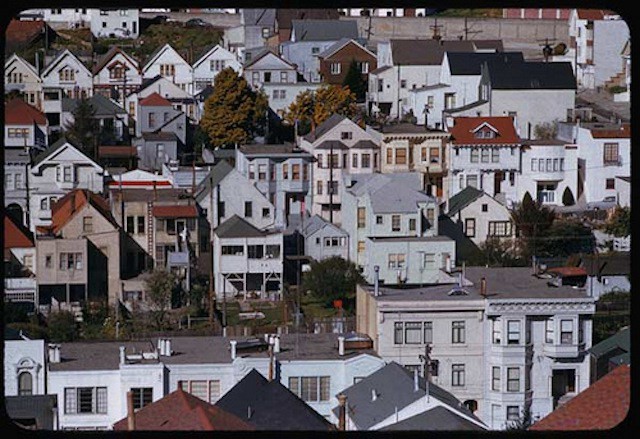Welcome To The New American Housing Bubble (In Coastal Elite Cities)

“Most of my buyers are averaging four offers before they have one accepted,” my new real estate agent in the Bay Area said yesterday. “It can be an emotional and stressful time.”
Probably! And especially if you’re moving from a still-depressed housing market, which is roughly the area between the Eastern Seaboard and San Francisco. But, as NPR is reporting as I type these words, the American housing market (in the coastal elite cities) is “fast changing.” From causing the collapse of the Earth’s economy just five years ago to a breezy NPR feature about an insane couple putting in offers at 2 a.m. after driving by a new listing, at night, the simple matter of having a place continues to cause misery, heartbreak and insomnia for those who would like to not deal with landlords and $5,000 monthly rents.
When the radio man says that “historically low interest rates are driving the recovery of the housing market” — a quote I just invented that you can probably hear, word for word, on Bloomberg right now — what he’s really saying is that rents are going crazy because enough people have money again to drive up the rents, but 3.4% annually on a half-million-dollar home means a monthly payment of about $1,800, after the 20% down payment of $100,000 (plus closing costs) you somehow have in the bank. Bring up your monthly house payment to $2,400 to include property taxes and homeowner’s insurance, and it’s still less than a three-bedroom place in a city with an economy. Especially if you need a patch of dirt outside for your dog to poop on.
If you cannot afford $5,000 a month for rent because you do not work for Facebook an hour away from San Francisco, buying is a “good idea,” and also the only other option beyond sleeping beneath the 101 … but only if you’ve somehow maintained your credit during the worst financial crisis of our lives, and also somehow saved a hundred thousand dollars, etc. And so people are buying anything, any old moldy box of urine-soaked flooring between a poison factory and a Pentecostal church, because it “makes financial sense.”
But is this growing frenzy real or is it just another bubble that will deflate as soon as underwater mortgage holders figure they can finally get out from their terrible investment of 2007? From another NPR housing story, this one about how it’s not actually fixed after all:
Despite a recent upturn in sales and prices, “the housing market is still very weak,” said Sheila Bair, who headed the Federal Deposit Insurance Corp. from 2006 to 2011. Bair, speaking at a Washington “economic summit” organized by The Atlantic magazine, warned homeowners that “we need more experience and data to know if it’s really turned around.”
Bair said lenders may be sitting on huge numbers of foreclosed upon houses that have been held back from the market. As housing prices start to perk up, that hidden inventory may come flooding into the market — and pushing prices back down, she said.
Moreover, millions of homeowners are “under water,” i.e., they still owe more on mortgages than they could get by selling their homes. As soon as they can sell at prices high enough to pay off old loans, they’ll put their properties on the market — and again drive down prices, she said.
This is still a problem even in fancy Twitter cities such as San Francisco, which is where Twitter is based and where Twitter itself stands as a temple to the way a cool tech company can save even a forever-doomed stretch of hobo land and plywood-covered windows like mid-Market Street.
Across from the new Twitter headquarters is an ugly brown stucco high-rise called Fox Plaza. It stands on the site of the beautiful old Fox Theater. When redevelopment bores approved the demolition of the grand theater in the 1960s, the Church of Satan’s Anton LaVay put a curse on the new building. Over the next forty years, not only the hideous Fox Plaza but the entire mid-Market Street corridor suffered endless humiliation and decay. The magic of Twitter has even reversed this satanic curse: Fox Plaza with its 1970s-style prison apartments now has a waiting list for bigger units, but you can get this nostalgic 1970s’ garbatecture one-bedroom for $3,070 per month.
Should all the financially strapped San Francisco homeowners suddenly put their homes on the market, it would make a dramatic difference in the current low inventory — 8% of the city’s homeowners still owe more on their bubble-era mortgage than the property’s current market value. But with values rising so fast, even houses that sold at the height of the 2007 insanity are getting close to parity. More houses on the market might bring some sense back to people, because it is reportedly damaging to sanity when you’re shown four crappy little houses that all need a lot of work, and you’re outbid on all of them, immediately.
Meanwhile, just an hour away in California’s Central Valley, lots of towns still have a huge shadow inventory of foreclosed homes and people waiting for the good times to return to Adobe Falls Estates behind the old Circuit City and the Applebee’s.
Related: Is San Francisco The Brooklyn To Silicon Valley’s Unbuilt Manhattan?
Photo by Charles Weever.
